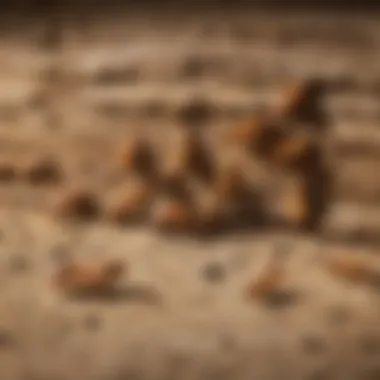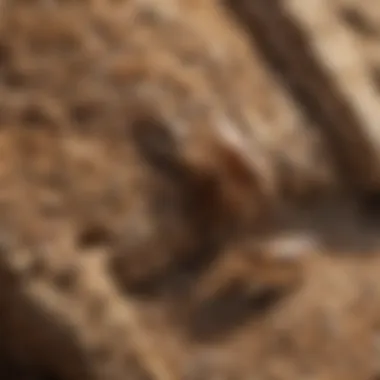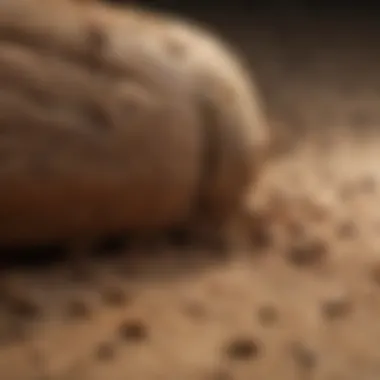Effective Ways to Eliminate Termites at Home


Intro
Termites represent a significant concern for homeowners. These pests can silently damage the foundation and structure of a house. Their presence can lead to expensive repairs and a reduction in property value. Understanding how to effectively handle a termite infestation is essential for maintaining the integrity of your home.
This guide provides essential information for identifying, treating, and preventing termite problems. Homeowners can take action against these pests through practical steps outlined in this article. With the right knowledge, they can address infestations decisively and protect their homes from future invasions.
Pest Identification
Identifying termites accurately is the first crucial step in controlling an infestation. There are several types of termites, but the most common are subterranean, drywood, and dampwood. Each type has unique behaviors and habitats.
Detailed descriptions of common pests
- Subterranean termites typically nest underground and need contact with soil for moisture. They are often found in colonies that can number in the millions. They enter homes through cracks in foundations or any wood in contact with the ground.
- Drywood termites do not require moisture from the soil and live within the wood they consume. They create colonies inside wooden structures, making them harder to detect.
- Dampwood termites thrive in moist and decaying wood. They often infest wood that has been damaged by water, such as in regions with high humidity.
Signs and symptoms of infestations
Identifying an infestation early can save time and money. Look for the following signs:
- Mud tubes: Subterranean termites construct mud tubes to travel between their nest and food sources. These tubes can be found along walls or foundations.
- Frass: Drywood termites leave behind droppings resembling sawdust. If you see this material beneath wooden structures, it may indicate a problem.
- Damaged wood: Tap on wooden surfaces to check for hollow sounds, which can signal wood that has been eaten away.
By recognizing these indicators, homeowners can act quickly to address termites before they cause more destruction.
Prevention Strategies
Preventing termite infestations is more effective than eliminating them. There are several strategies homeowners can implement to protect their properties.
Home maintenance tips for pest prevention
- Regular inspections: Conduct periodic checks of wooden structures and areas around your home.
- Moisture control: Limit moisture around your foundation by ensuring proper drainage and repairing leaks.
- Proper ventilation: Ensure attics and crawlspaces have adequate ventilation to reduce humidity.
Natural deterrents and barriers
- Boric acid: This natural pesticide can deter termites when applied to areas prone to infestations.
- Nematodes: Beneficial nematodes are microscopic worms that prey on termites. Introducing them to an area can help reduce pest populations.
Taking these precautions can significantly decrease the likelihood of a termite problem.
Treatment Options
When dealing with an active infestation, knowing the treatment options is essential. Homeowners can choose between chemical and natural treatments depending on their preferences.
Overview of chemical vs. natural treatments
- Chemical treatments include liquid insecticides and baits targeted at specific termite species. These can be effective but may require professional application.
- Natural treatments involve using substances like diatomaceous earth or orange oil, which can be safer for families and pets.
Step-by-step guides for DIY treatments
For those opting for a DIY approach, here is a simple method using bait:
- Identify the infestation area: Start by pinpointing where you see signs of termites.
- Create bait stations: Use untreated wood or cellulose materials placed near the infested area.
- Monitor: Check the bait stations regularly for termite activity.
- Apply natural deterrents: Use boric acid around the bait to create a barrier.
Implementing these methods can provide effective short-term solutions for termite issues.
By understanding the pest, applying prevention strategies, and utilizing proper treatment options, homeowners can manage termite infestations effectively.
Understanding Termites
Understanding termites is vital in addressing infestations. Knowledge about their biology, behavior, and types allows homeowners to approach termite control effectively. Proper identification leads to more precise treatments. For homeowners, recognizing the threats termites pose can be a game changer. It empowers them to take proactive measures to protect their property.
Biology and Behavior of Termites
Termites play a crucial role in the ecosystem, decomposing cellulose material like wood. They are social insects, living in colonies that can range from a few hundred to millions. This social structure allows them to work efficiently, building elaborate nests and tunnels. Their primary diet consists of cellulose, making wood, paper, and plant matter prime targets.


Understanding their behavior is essential when dealing with infestations. They are typically nocturnal, which means they are more active at night, often hiding during daylight. This can complicate early detection and removal strategies, as homeowners may not witness activity until significant damage has occurred.
Types of Termites Commonly Found
Identifying the specific type of termite involved can significantly influence removal methods. Here are the three major types:
Subterranean Termites
Subterranean termites are among the most destructive. They live underground and require moisture to survive, which makes them likely to infest homes built on or near soil. The key characteristic of subterranean termites is their mud tubes, which they construct for protection while traveling between their colony and food sources.
Their ability to cause extensive damage swiftly is alarming. They travel through these tubes to reach wood structures, often compromising foundations without immediate notice. This behavior underlines their importance in a termite removal guide.
Drywood Termites
Drywood termites differ from subterranean types. They can infest wood without the need for contact with soil, making them more challenging to detect. Their primary characteristic is the creation of small holes in wood, where they exit after feeding. This may also lead to frass accumulation, which resembles sawdust.
Drywood termites can be even more damaging in isolated wooden structures. Thus, understanding their behavior and signs is crucial for homeowners aiming to eliminate them. The unique feature of these termites is their capability to create colonies within wood, leading to extensive damage before any signs of infestation appear.
Dampwood Termites
Dampwood termites thrive in high-moisture environments. They are often found in decaying wood or areas of high humidity. The key characteristic of dampwood termites is their larger size compared to other types, which makes them distinct but they are usually less widespread. Their contribution to wood decay is significant, particularly in untreated areas vulnerable to moisture.
These termites do not typically infest homes unless there is a moisture problem. They prefer dead or decaying wood, which means managing moisture can effectively prevent these termites from becoming an issue. Understanding their unique preferences helps in assessing and addressing potential risks to a home.
Identifying a Termite Infestation
Identifying a termite infestation is crucial for homeowners. Early detection can save extensive damage and significant repair costs. Understanding signs of termite activity allows for timely intervention, potentially eliminating the pests before they cause extensive harm. Key elements include recognizing physical signs and employing methods to assess the level of infestation. This proactive approach is beneficial, as it provides clarity on the severity of the problem, allowing for appropriate action.
Signs of Termite Activity
Recognizing signs of termite activity is the first step towards addressing an infestation. These signs can vary but they are often quite revealing. They help homeowners understand whether they have a serious problem.
Presence of Mud Tubes
Mud tubes are one of the most recognizable signs of termite activity. These tubes are constructed by subterranean termites for traveling and protecting themselves from predators. They usually appear as small, pencil-sized structures made of mud, which connect the termite colony to the wooden sources they consume.
The presence of mud tubes indicates that termites are actively foraging for food. Homeowners should inspect areas like foundations, basements, and along exterior walls for these tubes. Removing mud tubes without treating the infestation will not help, as termites may rebuild them. Thus, their detection is essential for understanding the extent of the infestation, guiding the removal process effectively.
Damage to Wood Structures
Wood damage is another clear indicator of termites. When termites infest wood, they consume it from the inside out, leading to hollowed-out sections that may compromise structural integrity. Homeowners should look for sagging doors or windows, as well as floors that feel spongy.
Such physical indicators can guide homeowners in assessing which structures are at risk. The location of the damage can suggest the type of termites present, aiding in choosing appropriate removal strategies. Inspecting these damages allows homeowners to prioritize treatment areas based on the severity of damage observed.
Swarmers and Wings
Swarmers, the reproductive form of termites, are a significant sign of infestations. These winged insects emerge during warmer months, leaving their wings behind as they seek new locations to establish colonies. Finding discarded wings, usually near windows or doors, indicates that an active colony could be nearby.
Swarmers are a clear signal that termites are not only present but also reproducing. This knowledge can be alarming but is an essential factor in understanding the timeline of the infestation. Homeowners who notice swarmers should act quickly, as the presence of these insects suggests that the infestation is likely well-established and may require immediate attention.
Methods for Assessing Infestation Levels
Assessing infestation levels is a critical next step once signs have been identified. Various methods can be implemented to evaluate how extensive the problem is. Homeowners can inspect the affected areas carefully, looking for additional signs not only of present termites but also assessing the structural impact.
- Visual Inspections: Regularly inspect your home for mud tubes, damaged wood, and swarmer activity.
- Use of Tools: Employ specific tools like chisels and flashlights to look into hard-to-reach spaces for hidden damage.
Understanding the level of infestation informs the next steps in management and remediation. It can dictate whether natural remedies will suffice or if a more aggressive chemical treatment is necessary. Proper assessment lays the groundwork for effective termite control.
Do-It-Yourself Termite Removal Methods
Do-it-yourself termite removal methods provide homeowners with a valuable toolkit for managing and eliminating termite issues. They empower individuals by offering direct access to solutions that can reduce the financial burden of professional services. Understanding various methods is crucial, as maintaining control over one's home is not just about immediate removal but also about preserving the property and safeguarding against future infestations. Therefore, exploring both natural and chemical removal techniques, as well as effective application strategies, can equip homeowners with the knowledge they need to take action against termites.
Natural Remedies


Natural remedies have gained popularity among homeowners for their effectiveness and eco-friendliness. These methods help align personal values with practical solutions, ensuring minimal environmental impact.
Essential Oils
Essential oils like clove, neem, and orange oil have shown potential in deterring termites. Clove oil contains compounds that are lethal to termites and inhibit their reproductive capabilities. Its presence in the mix as a biopesticide is both effective and appealing to those looking for green solutions. While essential oils can serve as a beneficial option, effectiveness can vary based on concentration and application methods. One disadvantage is the requirement for frequent reapplication, especially in damp or humid conditions, which can decrease their practical usability over time.
Boric Acid
Boric acid is a common substance utilized in pest control, renowned for its effectiveness against termites. It works by damaging the termite's digestive system upon ingestion, leading to a gradual demise. Its ease of availability makes it a popular choice for homeowners. However, it is essential to apply it carefully, as direct contact with pets or children can be hazardous. The primary advantage lies in its effectiveness with continuous usage, although its limitations include a slower action compared to chemical solutions, necessitating patience in the eradication process.
Diatomaceous Earth
Diatomaceous earth is another natural remedy frequently used for termite control. This powder consists of microscopic fossilized aquatic organisms. It works through a desiccation process, essentially drying out the insects. The key characteristic of diatomaceous earth is its non-toxic nature, making it suitable for homes with children and pets. A unique aspect of this method is the requirement for thorough application in areas prone to termite activity. Its main disadvantage is that it must remain dry to maintain effectiveness; any moisture can render it ineffective throughout the treatment duration.
Chemical Solutions
Chemical solutions often provide immediate and potent pest control. They are formulated specifically for quick action against termites, making them a preferred choice for severe infestations.
Termiticides
Termiticides are chemicals explicitly designed to eliminate termites. Their fast-acting nature provides homeowners with immediate relief. Commonly, they form a protective barrier against future termites when applied correctly. Though beneficial for their quick results, potential downsides include toxicity concerns that necessitate careful handling and application to avoid human and ecological harm.
Foam Treatments
Foam treatments offer a unique form of application that penetrates hard-to-reach areas where termites may hide. The foam expands upon application, thoroughly covering surfaces. This method is advantageous due to its ability to access nesting areas in walls or other constricted spaces. However, the main drawback is that foam can be costlier than traditional liquid treatments, thus limiting its usability for budget-conscious households.
Earth Treatments
Earth treatments involve applying pesticide-laced soil around foundation areas to establish a barrier against termites. This method helps in preventing termite entry and is a long-lasting solution. The critical advantage is the ability to protect a home for prolonged periods effectively. However, it is essential to carefully plan its application since soil treatment requires maintenance over time to ensure its effectiveness and to address possible disturbances from landscaping or moisture changes.
Application Techniques
Understanding application techniques is vital for ensuring effectiveness and enhancing the overall success of termite removal efforts. Each method requires a different approach to maximize its impact.
Direct Application Methods
Direct application methods involve applying treatments directly onto visible termite-infested areas. This technique ensures a concentrated attack on the infestation. Its primary benefit is prompt action against visible populations. However, this method may miss hidden colonies, making it a less comprehensive approach when used in isolation.
Perimeter Treatments
Perimeter treatments are designed to create a protective barrier around the foundation of the home. Applying termiticides along the external perimeter not only targets existing termites but also deters future invasions. This method's major benefit lies in its preventive capability. A consideration is that it requires regular monitoring to maintain effectiveness, with potential reapplication needed based on environmental factors.
Baiting Systems
Baiting systems use strategically placed bait stations to lure and kill termites. They provide a proactive approach by targeting areas where termites are active. The unique feature of this method is its ability to eliminate entire colonies over time rather than just visible pests. However, it demands patience, as baiting systems may take weeks to show significant results, which can be less appealing to homeowners seeking immediate solutions.
The choice of termite removal methods should consider both the immediate needs and long-term goals of home protection.
Overall, combining various techniques may yield the best results while ensuring the homeowner's peace of mind about termite infestations.
Preventing Future Infestations
Preventing future infestations is as critical as removing existing termites. The significance of focusing on prevention cannot be understated. Once a termite infestation is controlled, homeowners must implement strategic measures to deter any potential return. Effective prevention not only protects your home but also saves time and money in the long run.
Implementing a combination of methods can build a strong defense against termites. This section explores various strategies that serve to reduce the likelihood of future infestations, ensuring that your living space remains secure and intact.
Eliminating Moisture Sources
Moisture is a key attraction for termites. Therefore, eliminating excess moisture around your home is essential. Inspect gutters and downspouts to ensure they direct water away from the foundation. Also, check for leaky pipes or fixtures, as even minor leaks can create ideal environments for termites to thrive.
Consider using dehumidifiers in damp areas like basements or crawlspaces to maintain low humidity levels. By making your home less appealing to termites, you take a significant step toward prevention. Also, be vigilant about yard drainage, ensuring that standing water does not pool near your home.
Wood Management Strategies


To further reduce the risk of termites, effective wood management strategies are necessary. The three main strategies include maintaining proper ventilation, conducting regular inspections, and using treated wood. Each of these methods plays a significant role in establishing a robust defense against potential infestations.
Proper Ventilation
Proper ventilation is crucial for maintaining a dry environment in your home. Good airflow prevents moisture buildup in isolated areas, which might attract termites. The presence of vents in attics, crawlspaces, and other enclosed areas ensures there is a constant flow of air. This measure is a beneficial choice for keeping wood structures in appropriate condition. However, it’s important to ensure that vents are not blocked by insulation or furniture, as this can negate their effectiveness.
Regular Inspections
Conducting regular inspections is essential for identifying early signs of an infestation. Homeowners should examine areas prone to moisture or wood accumulation at least once every six months. Regular checks can reveal small issues before they escalate into significant problems. This proactive measure can save money and maintain the integrity of your home.
Use of Treated Wood
Using treated wood is another effective strategy to prevent termites. Treated wood is infused with chemicals that deter pests, making it a much safer choice for construction and repairs. This material is especially beneficial for outdoor projects, such as decks or fences, where wood is exposed to the elements. However, treated wood may be more expensive compared to untreated alternatives. Still, the long-term protection provided justifies the initial investment.
In summary, effective prevention relies on a comprehensive approach that includes managing moisture and implementing smart wood management strategies. By applying these techniques, homeowners can significantly enhance their defenses against termites, securing their homes for the future.
When to Consider Professional Help
Termite infestations can escalate quickly. Homeowners may initially attempt to handle the situation themselves. But there are instances when professional help becomes necessary. Understanding the extent of the termite problem is crucial. It allows homeowners to gauge whether DIY methods will suffice or if expert intervention is required.
Professional exterminators possess the expertise to assess severe infestations more accurately. They can identify hidden colonies, which is essential because not all infestations manifest in visible damage. Engaging professionals ensures that the right methods are used, which can save time and resources in the long run.
Assessing the Severity of Infestation
Assessing the severity of a termite infestation involves determining the level of damage and the size of the colony. Techniques often include visual checks for signs like mud tubes or damaged wood. However, these methods can sometimes overlook large populations hidden within walls or foundations.
Homeowners should take note of the following indicators:
- Extent of damage: Serious consequences can arise from untreated infestations.
- Location of activity: Infestations occurring in key structural areas require prompt attention.
- Time involved: Prolonged undetected infestations can complicate damage significantly.
A professional's assessment can clarify the infestation’s scale, eliminating uncertainty.
Understanding Professional Services
Choosing to seek a professional service is often a critical decision. There are several components to this choice, which include inspection processes, treatment plans, and cost considerations.
Inspection Procedures
The inspection process is an essential part of termite control services. This process aims to identify all active infestations and possible entry points. During the inspection, professionals use a combination of visual checks and advanced tools like moisture meters and infrared cameras to uncover hidden colonies.
The main characteristic of inspection procedures is thoroughness. A detailed assessment can uncover areas that homeowners may easily overlook. The unique aspect of these procedures is that they often include a detailed report. This can serve as a baseline for monitoring the effectiveness of future treatments. A skilled inspection provides significant benefits, as it targets the most affected areas, ultimately saving on unnecessary treatments.
Treatment Plans
Once the infestation is assessed, a treatment plan is crafted. These plans are tailored based on the infestation's severity and location. The plan may include chemical treatments, baiting systems, or integrated pest management strategies.
The key characteristic of treatment plans is their custom approach. Each plan is unique, allowing for flexibility in addressing various infestation types. A treatment plan that includes follow-up assessments helps monitor the results. This can be especially beneficial for dealing with termite issues as they can often remain undetected for quite some time.
Cost Considerations
When considering professional assistance, cost is a significant factor. Homeowners need to weigh the expenses of professional services against potential damage costs from infestations. The cost may vary based on the infestation severity, treatment complexity, and geographical location.
A key aspect of cost considerations lies in understanding what is included in the service. Not only should one account for the initial inspection and treatment, but also for any follow-ups or warranties provided. A well-outlined cost analysis can make professional services a worthwhile investment in the long-term integrity of the home.
"Investing in professional help may seem costly at first, but addressing termite infestations early on can prevent more significant financial burdens later."
Finale
In grappling with the persistent issue of termites, summarizing the vital elements discussed throughout this guide is essential. This article serves not only as a roadmap for identifying, assessing, and eliminating termite infestations, but also emphasizes the importance of proactive measures to safeguard your property. The benefits derived from understanding termites extend beyond mere removal; they encompass a broader awareness of home maintenance and structural integrity.
The exploration of natural remedies and chemical solutions provides homeowners a diverse arsenal to combat these pests. Each method discussed offers unique advantages and aligns with various personal preferences regarding environmental impact and efficacy. Homeowners can approach the issue with confidence, knowing viable options exist to tackle the problem effectively.
In addition to removal techniques, attention must be paid to preventative strategies. Establishing practices to eliminate moisture and carefully managing wood within and around the home prove critical in curtailing future infestations. Regular inspections and maintenance can save homeowners from the stressful consequences of a severe termite problem later on.
Ultimately, recognizing when to seek professional help is equally important. A clear understanding of the severity of the situation enables homeowners to make informed decisions about whether to engage experts. Knowledge of inspection procedures and treatment plans, alongside cost considerations, equips individuals with the facts necessary to evaluate professional services rationally.
"A stitch in time saves nine." Addressing termite infestations promptly and comprehensively can protect one’s home and peace of mind.
By synthesizing the information presented, this guide aims to empower homeowners to take action decisively and pragmatically. Embracing a vigilant and informed approach not only mitigates the immediate threat posed by termites but also fortifies one’s environment against future incursions. In the end, the more educated one becomes regarding termites, the less daunting the task of managing these pests appears.



